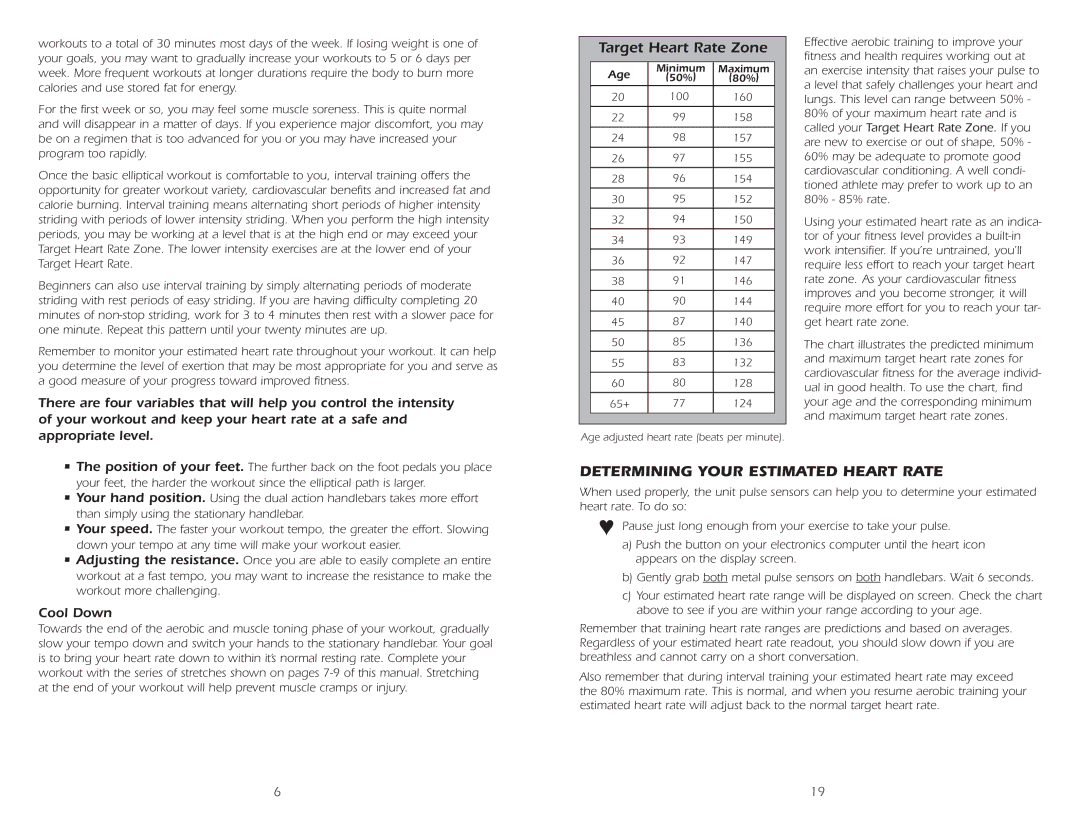
workouts to a total of 30 minutes most days of the week. If losing weight is one of your goals, you may want to gradually increase your workouts to 5 or 6 days per week. More frequent workouts at longer durations require the body to burn more calories and use stored fat for energy.
For the first week or so, you may feel some muscle soreness. This is quite normal and will disappear in a matter of days. If you experience major discomfort, you may be on a regimen that is too advanced for you or you may have increased your program too rapidly.
Once the basic elliptical workout is comfortable to you, interval training offers the opportunity for greater workout variety, cardiovascular benefits and increased fat and calorie burning. Interval training means alternating short periods of higher intensity striding with periods of lower intensity striding. When you perform the high intensity periods, you may be working at a level that is at the high end or may exceed your Target Heart Rate Zone. The lower intensity exercises are at the lower end of your Target Heart Rate.
Beginners can also use interval training by simply alternating periods of moderate striding with rest periods of easy striding. If you are having difficulty completing 20 minutes of
Remember to monitor your estimated heart rate throughout your workout. It can help you determine the level of exertion that may be most appropriate for you and serve as a good measure of your progress toward improved fitness.
There are four variables that will help you control the intensity of your workout and keep your heart rate at a safe and appropriate level.
Target Heart Rate Zone
Age | Minimum | Maximum |
(50%) | (80%) | |
20 | 100 | 160 |
|
|
|
22 | 99 | 158 |
|
|
|
24 | 98 | 157 |
|
|
|
26 | 97 | 155 |
|
|
|
28 | 96 | 154 |
|
|
|
30 | 95 | 152 |
|
|
|
32 | 94 | 150 |
|
|
|
34 | 93 | 149 |
|
|
|
36 | 92 | 147 |
|
|
|
38 | 91 | 146 |
|
|
|
40 | 90 | 144 |
|
|
|
45 | 87 | 140 |
|
|
|
50 | 85 | 136 |
|
|
|
55 | 83 | 132 |
|
|
|
60 | 80 | 128 |
|
|
|
65+ | 77 | 124 |
|
|
|
Age adjusted heart rate (beats per minute).
Effective aerobic training to improve your fitness and health requires working out at an exercise intensity that raises your pulse to a level that safely challenges your heart and lungs. This level can range between 50% - 80% of your maximum heart rate and is called your Target Heart Rate Zone. If you are new to exercise or out of shape, 50% - 60% may be adequate to promote good cardiovascular conditioning. A well condi- tioned athlete may prefer to work up to an 80% - 85% rate.
Using your estimated heart rate as an indica- tor of your fitness level provides a
The chart illustrates the predicted minimum and maximum target heart rate zones for cardiovascular fitness for the average individ- ual in good health. To use the chart, find your age and the corresponding minimum and maximum target heart rate zones.
•The position of your feet. The further back on the foot pedals you place your feet, the harder the workout since the elliptical path is larger.
•Your hand position. Using the dual action handlebars takes more effort than simply using the stationary handlebar.
•Your speed. The faster your workout tempo, the greater the effort. Slowing down your tempo at any time will make your workout easier.
•Adjusting the resistance. Once you are able to easily complete an entire workout at a fast tempo, you may want to increase the resistance to make the workout more challenging.
Cool Down
Towards the end of the aerobic and muscle toning phase of your workout, gradually slow your tempo down and switch your hands to the stationary handlebar. Your goal is to bring your heart rate down to within it’s normal resting rate. Complete your workout with the series of stretches shown on pages
DETERMINING YOUR ESTIMATED HEART RATE
When used properly, the unit pulse sensors can help you to determine your estimated heart rate. To do so:
♥Pause just long enough from your exercise to take your pulse.
a)Push the button on your electronics computer until the heart icon appears on the display screen.
b)Gently grab both metal pulse sensors on both handlebars. Wait 6 seconds.
c)Your estimated heart rate range will be displayed on screen. Check the chart above to see if you are within your range according to your age.
Remember that training heart rate ranges are predictions and based on averages. Regardless of your estimated heart rate readout, you should slow down if you are breathless and cannot carry on a short conversation.
Also remember that during interval training your estimated heart rate may exceed the 80% maximum rate. This is normal, and when you resume aerobic training your estimated heart rate will adjust back to the normal target heart rate.
6 | 19 |
